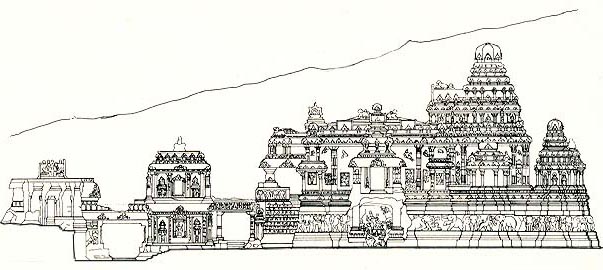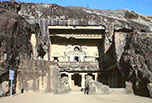|
PEACEFUL COEXISTENCE IN RELIGIONS
The starting age of excavations at Ellora was the finishing age at Ajanta, from the 6th to the 7th century, namely the time of decline of Buddhism in India.
Starting from the south, Caves 1 to 12 are Buddhist. There are 17 Hindu caves, Caves 13 to 29, and at some distance to the north, thre are 5 Jaina caves, starting at Cave30. Formerly it was considered that the caves were excavated in this order, but there is another belief that the Hindu caves were excavated earlier than the Buddhist.
 Three storied Buddhist Cave 11 ( 'Do Thal' )
Three storied Buddhist Cave 11 ( 'Do Thal' )
The Buddhist caves were excavated in the 7th and 8th centuries, over a distance of about 2km in the rock mountains of basalt. The new types of caves are Caves 11 and 12. The former was named misguidedly ‘Do Thal’ (2 floors), but it actually has three floors. The latter also has three floors, and is correctly named ‘Tin Thal’ (3 floors). Their facades with regularly arranged square columns and balconies give an impression of modern office buildings.
Their interiors consist of hypostyle halls with statues of figures from Mahayana Buddhism carved on side walls, and in a sacred cell at the rear a grand Buddha statue sculpted in sitting pose.
The sole Chaitya cave in Ellora is Cave 10 called the Vishwakarma Cave, which has a three-aisled hall with a large statue of Buddha in front of the stupa.
 Hindu Cave 16 ( Kailasa Temple )
Hindu Cave 16 ( Kailasa Temple )
THE MIRACULOUS KAILASA TEMPLE
There is a huge temple sculpted out of a rock mountain in Ellora, Cave 16, called Kailsa Temple. Both its inside and outside are completely carved and finished. A legend says that the second king Krishna I of the Rashtrakuta Dynasty prayed to the god Vishwakarma, who presides over architecture and craft, to accomplish the largest temple in Ellora and dedicate it to Shiva, and the god granted it with a magnificence beyond expectation.
 Looking toward sanctum in Kailasa Temple
Looking toward sanctum in Kailasa Temple
This HIndu temple, soaring in the center of a line of caves at Ellora, is astonishing. It is rather than a cave temple, it is better called a ‘rock-carved temple.’ This substantial monolithic temple is surmounted with a gigantic crowning stone of black basalt, and covered with fine carvings from top to bottom, showing a high level of craftsmanship.
The idea to carve out a freestanding temple in full from a rock was implemented in smaller scale in the famous example of the ‘Five Rathas’ in Mahabalipuram. The masons of Ellora carved out the Kailasa Temple in far larger scale by modeling upon the temple architecture of the Chalukya Dynasty in its capital Pattadakal, southern India.
Thus, the south Indian architectural style was introduced into Ellora in middle India. Its Vimana (main shrine) takes a pyramidal shape formed from piled horizontal rows in steps. Each row has chaitya windows and there are four lions sculpted in the round on the top of the Mandapa (worship hall). In front of the Vimana, there is a two storied shrine for a Nandi (bull), the vehicle of Shiva, accompanied by two Stambhas (memorial pillars) on both sides. These structures, including a front gate, are all carved out from a continuous rock, symbolizing the mythical Mount Kailasa in the Himalayas.
 Elevation of the Kailasa Temple
(From "Encyclopaedia of Indian Temple Architecture", vol. I-2, 1986)
Elevation of the Kailasa Temple
(From "Encyclopaedia of Indian Temple Architecture", vol. I-2, 1986)
There are numerous sculptures depicting diverse gods, demons, and imaginary animals, the skill of which one cannot help admiring. For example, Goddess Durga, consort of Shiva, on a lion’s back, is depictedon the south side of the entrance to the temple, bravely confronting Mahisha, the demon king with a buffalo head. This scene is based on the epics “Ramayana” or “Mahabharata,” in which Shiva and Vishnu, who could not defeat the demon king, hand over their symbolic weapons to her and this beautiful but merciless goddess throws the weapons to all sides with her ten arms.
Besides that, there are depictions of Lakshmi, the goddess of fortune and beauty, Ganesha with an elephant’s head, Kama, the goddess of love with a bow and arrows, and the goddesses of sacred rivers, Ganga and Yamna. However, there are unfortunately no completely preserved carvings depicting combat scenes and animals.
 Around Garbhagriha of Hindu Cave 29 ( Dhumar Lena )
Around Garbhagriha of Hindu Cave 29 ( Dhumar Lena )
CLOISTERS OF PANTHEON
Among Hindu caves, Cave 15, devoted to Vishnu, has seen many changes through history. It was excavated as a Buddhist Vihara (monastery) at the outset, but converted to a Hindu temple in the time of Rashtrakuta and came to be called Dashavatara (ten incarnations of Vishnu) cave. In the center of the courtyard surrounded by two storied caves, there is a monolithic Mandapa (worship hall), with statues carved in a niche decorated with chaitya windows, and real windows with latticework. Probably it was a Nandi Shrine. The main shrine is a hypostyle hall, the walls of which were the place for Hindu sculptors to display their skills.
Cave 21, called Rameshvara cave, the facade of which is made up of its richly carved columns, is regarded as one of the earliest Hindu caves at Ellora. Graceful Apsaras (celestial nymphs) are carved on the brackets of columns and the river goddesses Ganga and Yamna are on the walls of both sides. The tops of the inner pillars are cushion-type capitals, which are typical in north India.
One can see later techniques at Cave 29, called Dhumar Lena Cave. The sanctuary is not located in the center or in the rear of the main hall, but in an unusual location, similar to the cave in Elephanta Island. The axes from the three entrances cross each other and make a cruciform plan.
In the center of the sanctuary surrounded by colossal guardian figures known as Dvarapala, a Linga (phallus) is dedicated as the symbol of Shiva.
This sanctuary is a Chaturmukha (four faced) shrine, opened to four directions.
 Court of Jaina Cave 32 ( Indra Sabha )
Court of Jaina Cave 32 ( Indra Sabha )
DECLINE OF ELLORA CAVES
The final excavations at Ellora were carried out by Jains, who came here in the 9th century and excavated from Cave 30 to Cave 34. Inspired by the Hindu Kailasa Temple, they eagerly tried ‘Rock carved temples.’ Cave 30 has an extent of 25m in width by 40m in depth and is called Chhota (small) Kailasa Temple, but it was never completed and was abandoned. This smaller sized Kailasa has a sanctuary, on which a South Indian style Vimana used to stand, but the top part has been lost.
The finest among Jain caves is Cave 32, erroneously referred to as Indra Sabha (Indra’s Palace). A chaturmukha (four faced) shrine stands independently in the courtyard, next to a 10m higfh Stambha, and an elephant statue, and surrounded by two storied caves on three sides. This form of four faced shrine would develop immensely for Jain temples in western India in the medieval period, but here its roof takes the shape of South Indian style.
 Celestial Femail carved at Hindu Cave 21
Celestial Femail carved at Hindu Cave 21
The rear cave has a deep length and its pillars are splendidly carved. It is quite interesting to see how the positive and negative spaces facing each other, are excavated from the same rock mountain. Cave 32 also has a ceiling paintings. Though the last Cave 34 is a small cave, the composition of the interior space is the most excellent at Ellora.
Despite the Jain masons’ contribution, the ages of Ellora’s zenith came to an end, leaving some temples unfinished, after four centuries from the first excavations. However, differing to Ajanta, Ellora has never been forgotten, being always a sacred place for the three religions, which coexist till now.
(In "UNESCO World Heritage" vol. 5. 1997, Kodan-sha )
|

